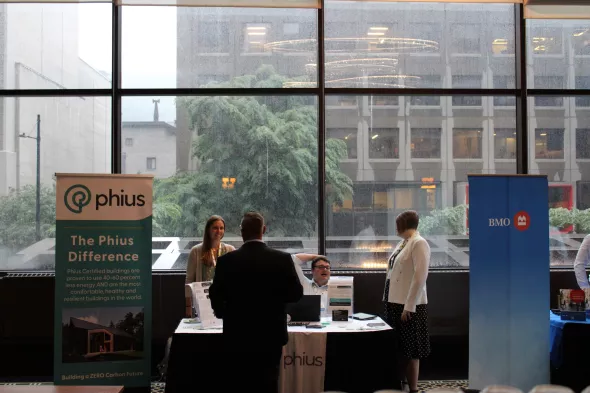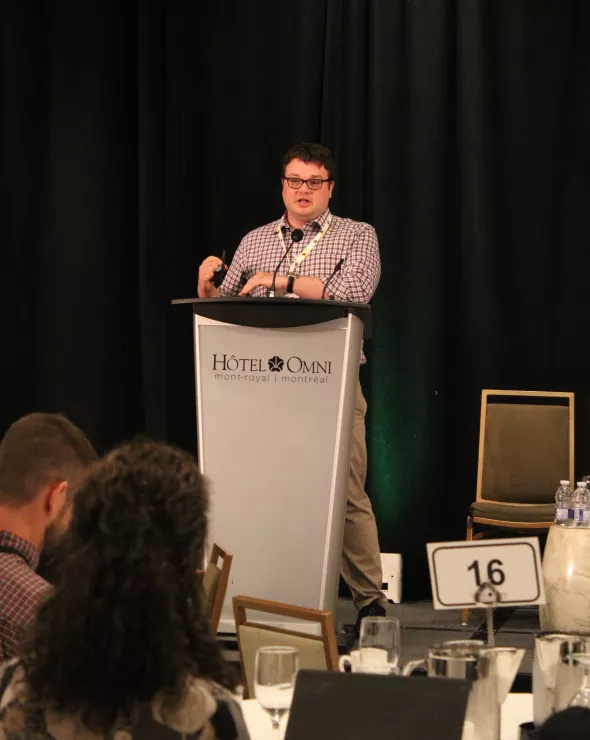Phius Brings REVIVE 2024 to Retrofit Canada Conference
Phius Project Certifier Al Mitchell breaks down a recent trip to the Retrofit Canada 2023 conference in Montreal.
Phius Project Certifier Al Mitchell breaks down a recent trip to the Retrofit Canada 2023 conference in Montreal.
Phius recently sponsored Retrofit Canada 2023, the third annual running of the event, following up on the success of our attendance in Toronto the previous year.
The conference has continued to see a rise in popularity as the industry works to catch up with the need to retrofit 4-5% of Canadian buildings annually to achieve net zero emissions by 2050. This is no small task, and includes approximately 9 million existing homes and 480,000 commercial buildings. To encourage further work on this, funding has been continuously released from the Canadian Federal Government, with the most recent call for proposals from Natural Resources Canada, which released a $200 million grant for deep energy retrofits as the Deep Retrofit Accelerator Initiative, which has an extended deadline for Indigenous applicants or applicants who focus on Indigenous communities.

Conference chair Corey Diamond, Executive Director at Efficiency Canada, opened the conference with some brief remarks and outlined three key tenets of this retrofit project: the implementation of stricter energy codes, focusing on the retrofit mission and ensuring accessibility for all. These points were covered by most of the presenters who followed, as they each discussed and explained how their work in the building retrofit realm responds to these concerns.
This conference is admittedly different from the conferences I typically attend, with an increased focus on policy and government programs, and a small collection of case studies and technical presentations mixed in to show policymakers and funders what the industry practitioners are currently working on.
As part of a governmental panel, during which representatives from different governmental bodies around the country spoke, Sean Pander from the City of Vancouver spoke on their advances in the energy code and regulations. From the policy perspective, the current workings in Canada vary throughout the country, as each province has the ability to implement their own codes and funding for projects. The Province of British Columbia, and more specifically Vancouver are leading the way in terms of codes and regulations for energy efficiency.
The City of Vancouver adopted Canada's first building performance standard (BPS) program in 2022 under the Annual Greenhouse Gas and Energy Limits Bylaw. This standard will regulate the onsite allowable carbon emissions from buildings greater than 100,000 sqft starting in 2024, with a tax of $375 CAD/ ton of CO2 for every ton over the allowance. While this would allow for the straight electrification of building systems to avoid any tax, there is also a peak heating limit of 1 GJ/sf to encourage building envelope upgrades. There are also incentive programs, making Vancouver a leader in energy efficiency code programs, and thankfully encouraging a holistic look into building performance.
From a panel of private sector leaders composed of bankers, fund managers and property managers, the important notes revolved around the market demands for Environmental and Social Governance (ESG) and public reporting and disclosure. There was broad consensus that public reporting requirements in various large cities: New York, Chicago, Toronto, Montreal, etc, where buildings are required to display an energy score on the entrance of the building has allowed tenants to easily identify if their building is performing well. As societal pressure pushes toward a zero carbon future, more tenants, both commercial and residential, are willing to push their building owners to improve performance – a flip on the classic landlord/ tenant dynamic.
Both panels agreed that the way funding for building and building retrofits needs a paradigm shift to accomplish the mission of retrofitting all buildings by 2050. The key is shifting from a simple payback measure of return on investment, and moving to a more lifecycle analysis cost structure (ADORB anyone?). This changes the way the economics work, and shows that over the span of a building's use, the more expensive retrofit will really save cost over this lifecycle. This also allows people to see the whole financial structure of the building in one location, and better assess the risk of investing in energy-inefficient projects.
There was also a note that for smaller buildings, such as single-family homes, banks should look into including the retrofit cost in the mortgage. This will better derisk these banks from homeowners going into energy-related debt, and reduce the chance of mortgage default.

Lisa White and I presented on REVIVE 2024 and the development of the standard. I feel this was well received, both by policymakers and the technical members of the audience, as it responded to the concerns of electrification, resilience / passive measures, and a life cycle cost analysis. REVIVE is the blend of all of these elements, and I think most critically, it serves as a decision tool to speed up this retrofitting process, another concern noted by many people.
In a country where the majority of the electricity is clean hydropower, it can be tough to justify some building envelope upgrades on a macroscale, especially to a passive level. Lisa’s research on the grid and her presentation at the conference sold to the audience the advantage of passive building to allow for load shifting as well as load shedding, which can keep the grid running on the hydropower rather than running fossil fuel intensive peaking plants.
Phius tabled at the event, one of my favorite activities for work, because I get to discuss passive building and our work that supports the Phius mission. We received positive feedback on our presentation, as well as a great deal of enthusiasm. I sincerely hope REVIVE 2024 can help accelerate the solving of the retrofit conundrum that our northern neighbors are facing.
Next year, Retrofit Canada 2024 will be held in Vancouver, and we look forward to it.